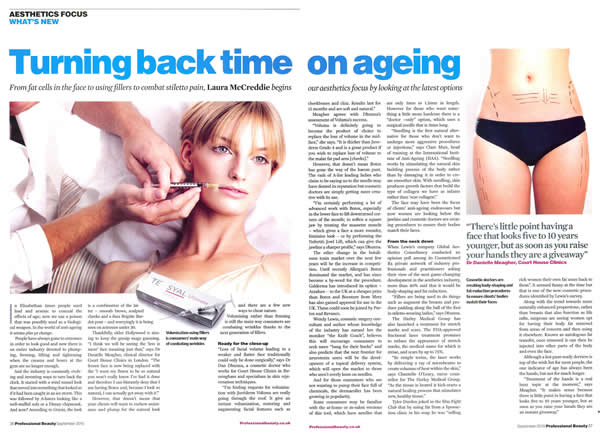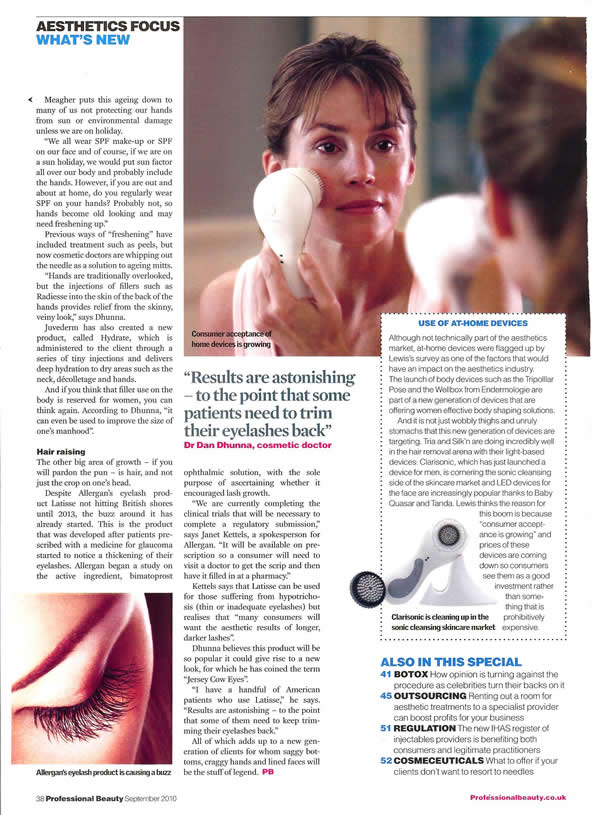 “Voluma is definitely going to become the product of choice to replace the loss of volume in the midface,”
“Voluma is definitely going to become the product of choice to replace the loss of volume in the midface,”
In Elizabethan times people used lead and arsenic to conceal the effects of age; now we use a poison that was possibly used as a biological weapon.
In the world of anti-ageing it seems plus ca change. People have always gone to extremes in order to look good and now there is an entire industry devoted to plumping, freezing, lifting and tightening when the creams and hours at the gym are no longer enough.
And the industry is constantly evolving and inventing ways to turn back the clock. It started with a wind tunnel look that moved into something that looked as if it had been caught in an ice storm. This was followed by A-listers looking like a well-stuffed sofa or a Disney chipmunk. And now? According to Grazia, the look is a combination of the latter – smooth brows, sculpted cheeks and a faux Brigitte Bardot pout – and worryingly it is being seen on actresses under 30.
Thankfully, older Hollywood is aiming to keep the gossip mags guessing. We will be seeing the ‘less is more’ face meaning just that. The frozen face is now being replaced with the ‘I want my Botox to be so natural you won’t really know I’ve had it done and therefore I can blatantly deny that I am having Botox and, because I look so natural, I can actually get away with it’:’
However, that doesn’t mean that your clients will want to eschew assistance and plump for the natural look and there are a few new ways to cheat nature.
Volumising rather than freezing is still the main way consumers are combating wrinkles thanks to the next generation of fillers.

Ready for the close-up
“Loss of facial volume leading to a weaker and flatter face traditionally could only be done surgically,” says Dr Dan Dhunna, an advanced cosmetic doctor who specialises in skin rejuvenation techniques. “I’m finding requests for volumisation with ]uvederm Voluma are really going through the roof. It give an instant volumisation, restoring and augmenting facial features such as cheekbones and chin. Results last for 15 months and are soft and natural.”
Meagher agrees with Dhunna’s assessment of Voluma’s success. “Voluma is definitely going to become the product of choice to replace the loss of volume in the midface,” she says. “It is thicker than Juvederm Grade 4 and is a great product if you wish to replace loss of volume to the malar fat pad area [cheeks].”
However, that doesn’t mean Botox has gone the way of the harem pant. The rash of A-list leading ladies who claim to be saying no to the needle may have dented its reputation but cosmetic doctors are simply getting more creative with its use. “I’m certainly performing a lot of advanced work with Botox, especially in the lower face to lift downturned corners of the mouth; to soften a square jaw by treating the masseter muscle – which gives a face a more rounder, feminine look – or by performing the Nefertiti Jowl Lift, which can give the jawline a sharper profile;” says Dhunna.
The other change in the botulinum toxin market over the next few years will be the increase in competition. Until recently Allergan’s Botox dominated the market, and has since become a by-word for the procedure.
Galderma has introduced its option – Azzalure – to the UK at a cheaper price than Botox and Bocoture from Merz has also gained approval for use in the UK. These could soon be joined by Purtox and Revance.
Wendy Lewis, cosmetic surgery consultant and author whose knowledge of the industry has earned her the moniker “the Knife Coach”, believes this will encourage consumers to seek more “bang for their bucks” and also predicts that the next frontier for neurotoxin users will be the development of a topical delivery system, which will open the market to those who aren’t overly keen on needles.
And for those consumers who are not wanting to pump their face full of chemicals, the dermaroller has been growing in popularity. Some consumers may be familiar with the at-home or in-salon versions of this tool, which have needles that are only 1mm to 1.5mm in length However for those who want some thing a little more hardcore there is a “doctor -only” option, which uses a surgical needle that is 3mm long. “Needling is the first natural alternative for those who don’t want to undergo more aggressive procedures or injections,” says Clare Muir, head of training at the International Institute of Anti-Ageing (IIAA). “Needling works by stimulating the natural skin building process of the body rather than by damaging it in order to create smoother skin. Witj needling, skin produces growth factors that build the type of collagen we have as infantsrather than ‘scar collagen’.”
The face may have been the focus of clients’ anti-ageing endeavours but now women are looking below the jawline and cosmetic doctors are creating procedures to ensure their bodies match their faces.
From the neck down
When Lewis’s company Global Aesthetics Consultancy conducted an opinion poll among its Cosmeticmed Rx private network of industry professionals and practitioners asking their view of the next game-changing development in the aesthetics industry, more than 40% said that it would be body-shaping and fat reduction.
“Fillers are being used to do things such as augment the breasts and produce padding along the ball of the foot in stiletto-wearing ladies;’ says Dhunna.
The Harley Medical Group has also launched a treatment for stretch marks and scars. The FDA-approved fractional laser treatment promises to reduce the appearance of stretch marks, the medical name for which is striae, and scars by up to 75%.
“In simple terms, the laser works by delivering a ray of microbeams to create columns of heat within the skin;’ says Chantelle O’Leary, nurse counsellor for The Harley Medical Group. “As the tissue is heated it kick-starts a natural healing process that stimulates new, healthy tissue?’ Tyler Durden joked in the film Fight Club that by using fat from a liposuction clinic in his soap he was “selling rich women their own fat asses back to them”. It seemed funny at the time but that is one of the new cosmetic procedures identified by Lewis’s survey.
Along with the trend towards more naturally enhanced proportions, rather than breasts that also function as life rafts, surgeons are seeing women opt for having their body fat removed from areas of concern and then using it elsewhere. Known as autologous fat transfer, once removed it can then be injected into other parts of the body and even the face.
Although a hot pant-ready derriere is top of the wish list for most people, the one indicator of age has always been the hands, but not for much longer. “treatment of the hands is a real buzz topic at the moment,” says
Meagher. “It makes sense because there is little point in having a face that looks five to 10 years younger, but as soon as you raise your hands they are an instant giveaway!’

Meagher puts this ageing down to many of us not protecting our hands from sun or environmental damage unless we are on holiday. “We all wear SPF make-up or SPF on our face and of course, if we are on a sun holiday, we would put sun factor all over our body and probably include the hands. However, if you are out and about at home, do you regularly wear SPF on your hands? Probably not, so hands become old looking and may need freshening up.”
Previous ways of “freshening” have included treatment such as peels, but now cosmetic doctors are whipping out the needle as a solution to ageing mitts. “Hands are traditionally overlooked, but the injections of fillers such as Radiesse into the skin of the back of the hands provides relief from the skinny, veiny look;” says Dhunna.
Juvederm has also created a new product, called Hydrate, which is administered to the client through a series of tiny injections and delivers deep hydration to dry areas such as the neck, decolletage and hands. And if you think that filler use on the body is reserved for women, you can think again. According to Dhunna, “it can even be used to improve the size of one’s manhood”.
Hair raising
The other big area of growth – if you will pardon the pun – is hair, and not just the crop on one’s head. Despite Allergan’s eyelash product Latisse not hitting British shores until 2013, the buzz around it has already started. This is the product that was developed after patients prescribed with a medicine for glaucoma started to notice a thickening of their eyelashes. Allergan began a study on the active ingredient, bimatoprost ophthalmic solution, with the sole purpose of ascertaining whether it encouraged lash growth. “We are currently completing the clinical trials that will be necessary to complete a regulatory submission,” says Janet Kettels, a spokesperson for Allergan. “It will be available on prescription so a consumer will need to visit a doctor to get the scrip and then have it filled in at a pharmacy.” Kettels says that Latisse can be used for those suffering from hypotrichosis (thin or inadequate eyelashes) but realises that “many consumers will want the aesthetic results of longer, darker lashes”
Dhunna believes this product will be so popular it could give rise to a new look, for which he has coined the term “Jersey Cow Eyes”. “I have a handful of American patients who use Latisse,” he says. “Results are astonishing – to the point that some of them need to keep trimming their eyelashes back.”
All of which adds up to a new generation of clients for whom saggy bottoms, craggy hands and lined faces will be the stuff of legend.
